Social media has become fully integrated into the marketing mix for businesses as having a presence on each social media channel has become necessary for every business. Continuously monitoring your social media channels and creating organic content to be delivered frequently and actively is key to any good social media strategy. Organic posts and engaging with users across your social media channels builds an online community for your hotel, which is great for building a brand identity and spreading awareness. However, the world of social media is constantly evolving and the game has changed from organic content to pay-to-play.
It is now imperative for hoteliers to allocate resources for paid social campaigns across the social media channels they are presently on. Spending the money on these campaigns will help further spread brand awareness, and overall drive traffic to your hotel’s website. According to tracx, spending on ads has increased 185% since 2014 and 78.5% of people are more likely to visit a brand’s website after viewing a paid ad.
Know Your Goal and Budget Before You Start
When approaching a paid social media campaign for the first time, start off by tackling it like any other traditional advertising campaign. The first thing you need to determine is what you want to accomplish with your campaign. Are you looking to drive conversions on your booking site, increase RFP submissions for meetings & events, or are you simply looking to expand brand awareness and gain page likes? All of these can be achieved through a paid campaign and your end goal will determine which objective you will select when setting up your campaign.
Facebook and Instagram
Note: All Instagram campaigns are created through Facebook’s Ad Manager, so the same information applies when we mention Facebook ads.
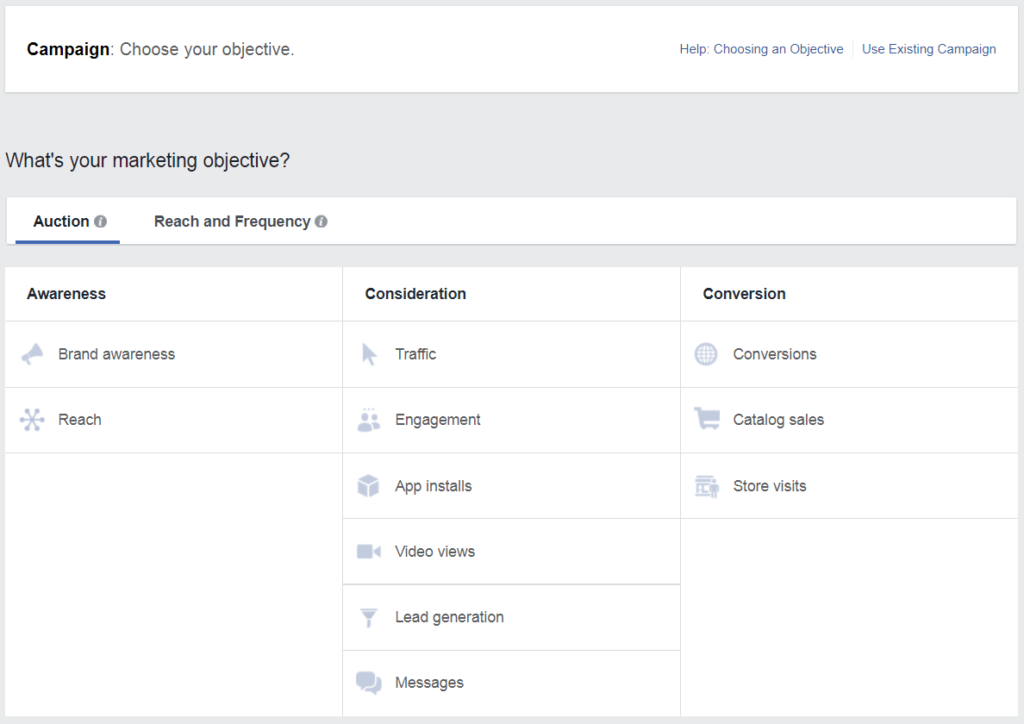
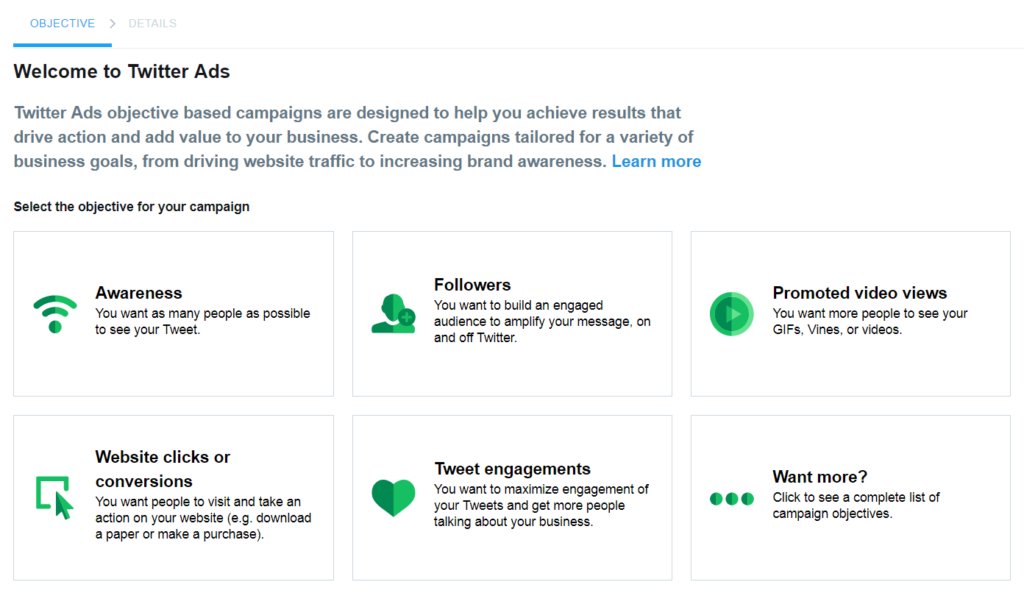
As with any advertising campaign, whether it be traditional or digital, the biggest factor in your campaign is the budget. While having a big budget for a paid social campaign is great, it does not take a ton of money to make waves towards your goal. The advertisement(s) itself will be the main factor affecting campaign results. A lot of money can be put behind a campaign, but if the advertisements are not eye-catching and the copy is not enticing, it will not matter how much money was spent.
Facebook and Instagram campaign budgets operates in two ways. You can set a “lifetime” budget (the amount you will spend over the entire runtime of your ad set) or a daily budget (the amount you will spend on an ad set every day.). Facebook uses this money and delivers your ads towards users fitting your audience criteria. Facebook’s automatic placements and bidding algorithm is a great option if you are not quite the Facebook ad expert yet. AdEspresso notes using Facebook’s automatic bids is the smartest choice and the auto-optimization algorithm really gets the job done.
Standard delivery with automatic placements is your best bet for running ads as it you will run and deliver as many ads as possible for the lowest price available. If you are running a last minute sale and want to run a campaign to spread awareness, select accelerated delivery to get your ads in front of as many eyes as quickly possible. As you become a Facebook and Instagram advertising pro, you can manually select placements and choose your own Facebook bidding strategies to potentially help lower your cost-per-click. Facebook’s campaign creator can seem daunting to first-time users; however, know that its preset delivery methods and bidding systems are completely reliable and will help you get the most bang for your buck on advertisements. Visit the Facebook Business Community for more information on budgets, bidding strategies, and schedules.
Setting up a budget in Twitter Ads is very similar to Facebook; however, there is one key difference. On Twitter, you must select a daily budget; setting an overall total budget is optional. In this instance, you can decide how much you would like to spend each day your ads run continuously or you can determine your total budget and do the math to set a daily budget depending on how long you would like to run your ads.

Define Your Audience and Plan Accordingly
Selecting your audience is vital in any advertising campaign. Facebook and Twitter can help you hone in on people who meet specific demographics, behaviors, and interests you are trying to target.
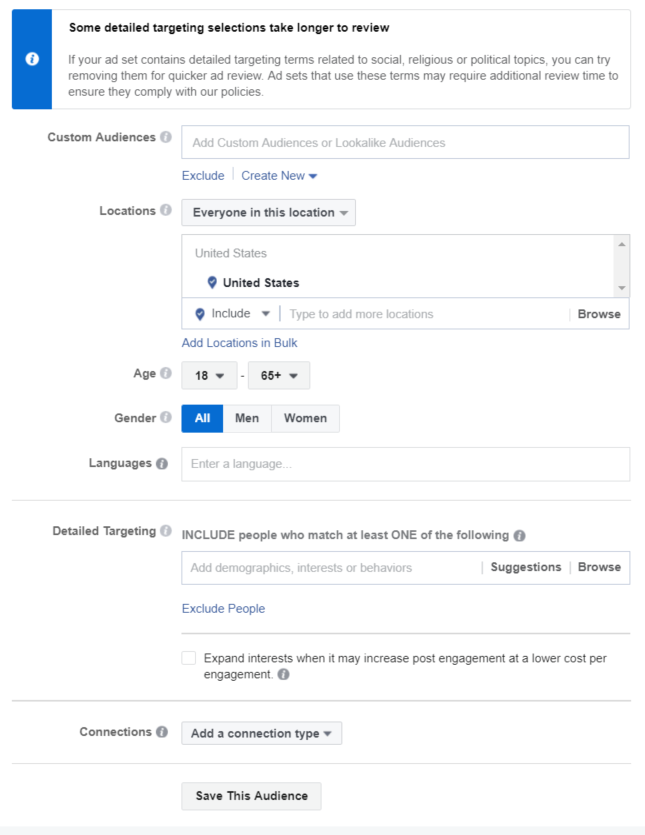
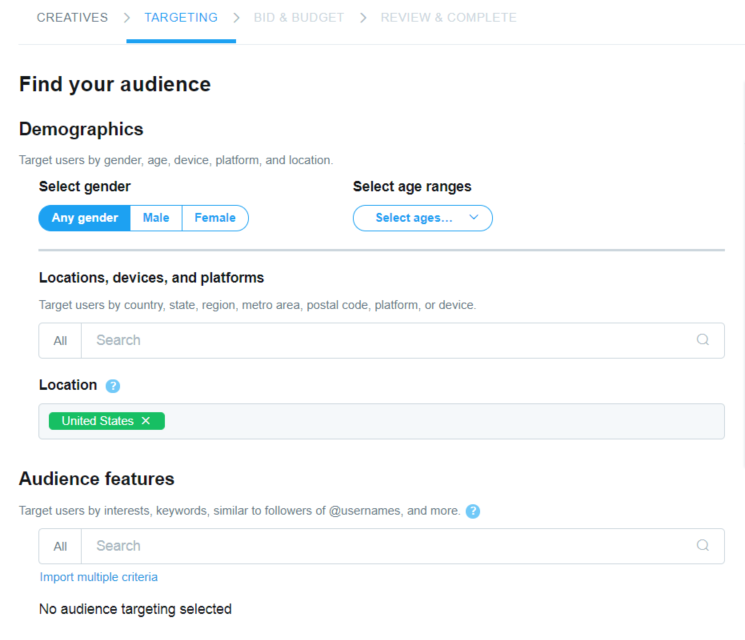
Facebook allows you to delve deeper into audience specifics such as relationship status or people who have children, or even purchase behaviors. These traits are great to implement into your targeting strategy when you’re trying to reach people who meet these characteristics. For example, targeting users who are recently engaged would be perfect if you are looking to promote a romance package or advertise your hotel’s wedding venue. Additionally, Facebook allows you to target more broad interests such as travel, sports teams, and brands, to name a few. These interests would be great to choose if you are located near a university or close to where a professional sports team plays, as this could allow you to go after fans of those specific teams and sports. Another cool feature is Facebook allows you to save audiences so they can be reused in the future and it also lets you adjust and make tweaks to saved audiences. Your Facebook targeting strategy can be the most challenging step in setting up your campaign, but it is crucial to make sure your reaching as many people in your targeted audience to earn the best results.
Twitter’s audience selector is similar in nature to Facebook with just a few minor differences. One notable feature on Twitter is that you can go after look-alike followers from specific accounts. For hoteliers, it would be a great idea to go after lookalike followers from competitors in your hotel’s area or travel accounts such as TripAdvisor, Expedia, and Booking.com since these are likely the same people in your targeted audience. Facebook also has a lookalike audience feature but differs from Twitter’s as it allows you to create lookalike audience of people similar to fans of your page or best existing customers.
If you find your ads are not performing as well as you had hoped or
need a better picture on which demographics, interests and behaviors make up your profile’s current audience, take a look at who your current fan-base is. This information can be found under your Analytics tab on Twitter and Insights tab for Facebook and Instagram. Applying these same demographics and characteristics to the audience you are targeting in your ads could make a huge difference in your campaigns performance.
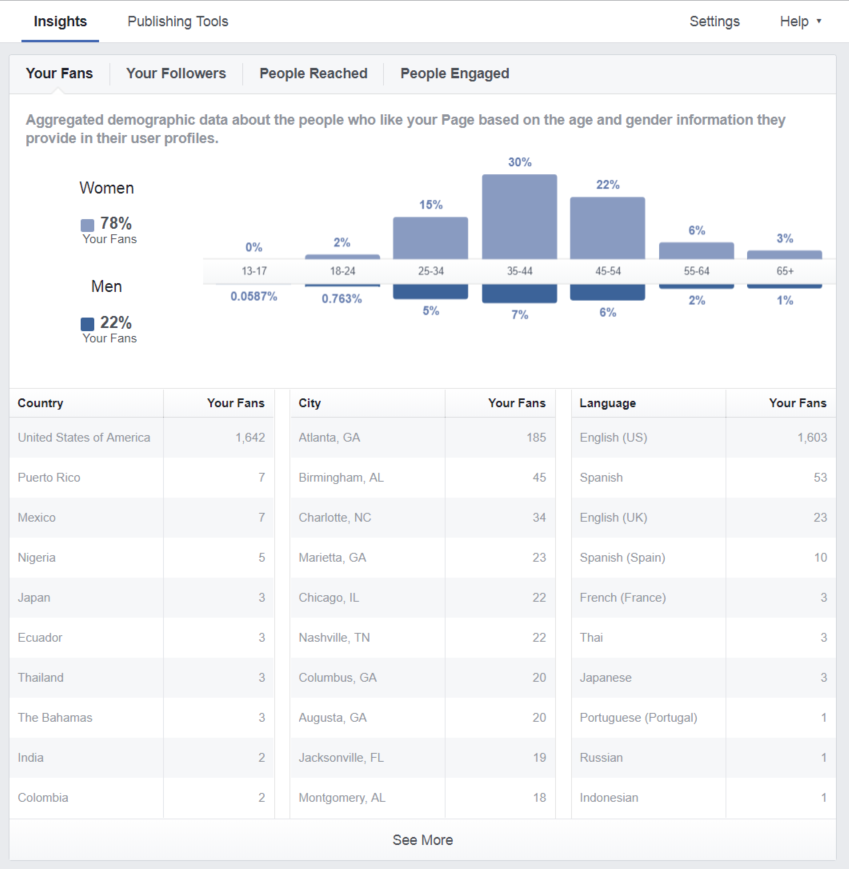
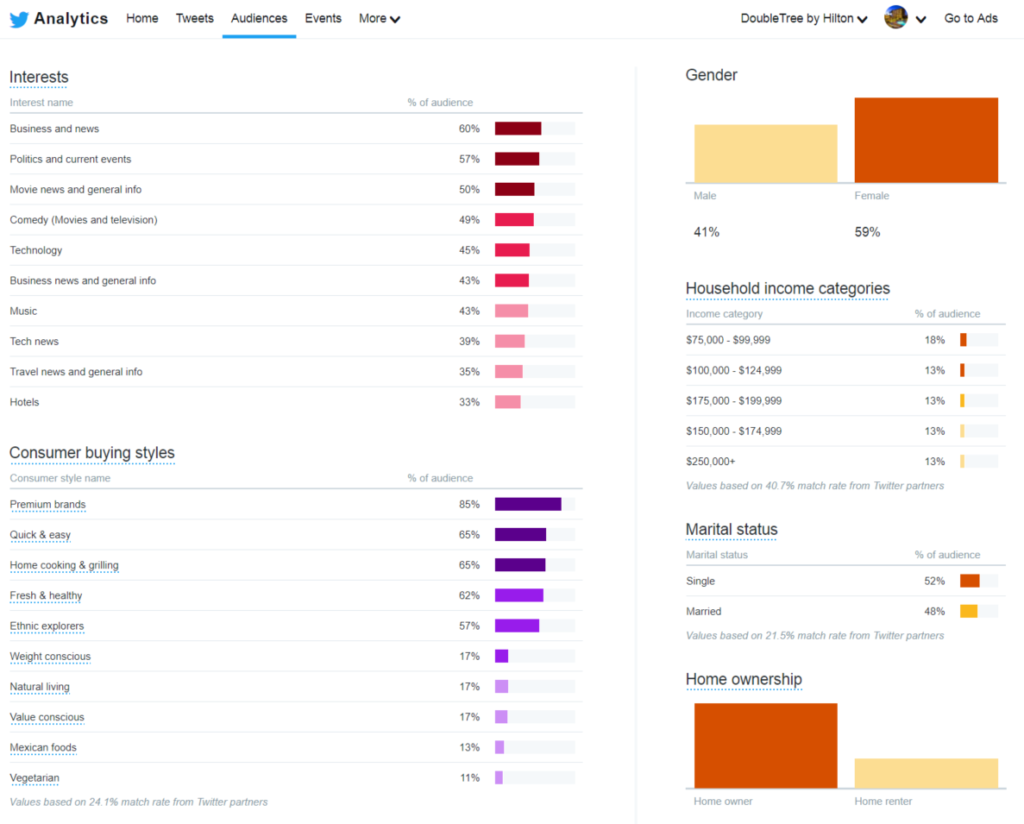
One factor in capturing your audience is knowing what time to run an ad. While Facebook and Twitter does the grunt work in delivering your ads, it is important to select dates that align with your campaign. For example, if your campaign is focused on targeting couples for a labor day getaway to your hotel, start running your ad a month or so before the holiday. If your campaign is more general, you do not need to focus as much on what specific dates and times to run your advertisements.
Create Engaging Ads
There are many options when it comes to visuals for paid social campaigns depending on the platform. Facebook has a variety of options such as a single image, video, or even an image carousel. While you have several options on what form of advertisements to run on Facebook and Twitter, stick to these rules overall:
- Enticing images of hotel or landscape pictures of area. The visual catches your audience’s attention and draws them in to taking action on your advertisement. Try to not use any text on photos, as it can cause a decrease in your reach. Leave all the text to your copy.
- Keep your copy simple but catchy. Use descriptive language or engage your audience with a question. Your audience wants to hear about how comfortable your beds are or how luxurious the amenities are at your hotel.
- Use personalization (if warranted) in your ads. If you are targeting women who are recently engaged to gain RFPs on your wedding venue, run ads with copy specifically talking to that excited bride-to-be.
For hoteliers, one thing to always do is to use ads showing off how beautiful your hotel is. People want to see where they will stay before booking so the better the photography, the more interaction you will have from your ads. The better the ads you create and publish, the better results you will see. Additionally, the more actions on your ad, the lower your cost-per-click (CPC) will be and in turn, a higher return on your investment. One thing to keep in mind on Twitter is you might want to play around with running ads with an image vs. ads without an image and see what performs best for you.
Optimize for Mobile
The last thing to remember when creating a paid social campaign is, optimizing it for how it will be viewed on mobile. Always check the preview functions to see what the advertisement will look like on desktop version, but most specifically on mobile. Look over images to make sure they are still just as visible and eye-catching on a smaller screen. Double check images are not getting cut off, text on images (if applicable) is still readable, and your copy is not so long that it distracts. According to Hootsuite, in 2016 social media use on mobile increased by 30 percent year-over-year and surpassed 2.5 billion users globally. A mobile device is where most social media users will view your ad from, so it is essential all of your advertisements are optimized for mobile.
In a Nutshell…
Paid social media is not going away and it needs to be an integrated component to your marketing plan. Hootsuite notes over 2 million advertisers regularly use Facebook to market their business. The playing field is no longer even and you have to put money behind your accounts. Fortunately, businesses, even hotels, are finding the return on investment is worth the money. Follow these tips to get started on a paid social campaign and you will be running paid campaigns like a pro.
For more advice on how to improve your social media strategy, check out more articles on our blog or contact us.




